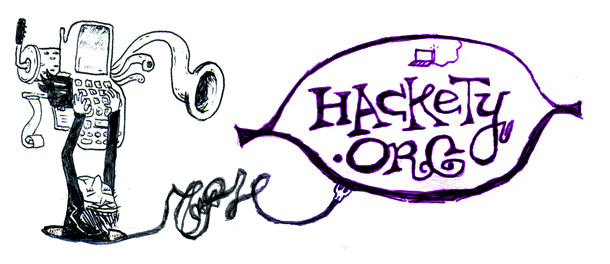Mashing In Some Graphics
Okay, so, all these samples so far have used stacks and flows to get all the text and buttons and stuff into place. This way it all happily resizes just like a browser would.

But it all ultimately just gets pasted in the square. And, so, Shoes offers a NodeBox-like set of methods for painting in the window bounds. Check this out. (And see below for updated code!)
rectangles = proc do
20.times do
nostroke
fill rand(0.6) + 0.4, rand(0.1) + 0.9,
rand(0.2) + 0.8, rand(0.4) + 0.1
r = rand(300) + 60
rect rand(100), rand(200), r, r
end
button "OK", :x => 300, :y => 400 do
clear &rectangles
end
end
Shoes.app :width => 400, :height => 500, &rectangles
These calls aren’t just inspired by NodeBox. I tried to match things as close as possible. In retrospect, however, I might end up using an options hash. (So rectangles would be: rect :x => 10, :y => 10, :height => 50, :width => 50. Not too sure yet.)
The hacketiest part about this sample though is the clear method. That method there. It wipes the window. And if you pass it a block, it’ll use that to rebuild the window. Anyway, there are lots of ways to alter and clear out elements. Or swap in new ones. (Sorry I got no docs. Experimental shoes season ends September 1st.)
Update: This sample has changed in recent builds of Shoes. Try:
Shoes.app :width => 400, :height => 500 do
rectangles = proc do
20.times do
nostroke
fill rgb(rand(0.6) + 0.4, rand(0.1) + 0.9, rand(0.2) + 0.8, rand(0.4) + 0.1)
r = rand(300) + 60 # radius
rect rand(100), rand(200), r, r
end
button "OK", :top => 300, :left => 400 do
# clear wipes out the window and uses the passed block to repaint
# it again.
clear &rectangles
end
end
rectangles.call
end


Now begin the comments …
Jon Leighton
You realise that
rand(0.6)can return a value greater than 0.6 because the argument is convertedto_i?Other than that, cool. Have you looked at Scribble lately? Our syntax is nicer than NodeBox :)
Jon Leighton
Just to be uber-correct, the actual reason it can be great than 0.6 is because
Kernel#rand“converts max to an integer usingmax1 = max.to_i.abs. If the result is zero, returns a pseudorandom floating point number greater than or equal to 0.0 and less than 1.0.”Drew Olson
I’m very intrigued by the project, but for some reason the last two samples aren’t working for me on my windows system. The simple editor will not update when I press keys and in today’s sample there is no color differentiation between rectangles. Plus I get some bizarre error when I click “OK”.
Don’t mean to rant, I absolutely love your projects and enjoy following this blog. Just thought you might like to know that I’m getting some weird behavior on the windows end.
_why
Jon Leighton: I couldn’t seem to find Scribble last I checked. Anyway, good tips on rand.
Drew Olson: If you’re using the binary builds, they’re a bit behind. I’m working on getting a new one out today, but the only way to keep up is to build shoes yourself. Which has become much easier as of today.
Jon Leighton
We don’t have a website yet but we have:
Progress is a bit slow at the moment because both Nathan and I are quite busy, but when we get a 0.1 out the door we intend to push for some more developers in order to keep the ball rolling.
Stuff I particularly like about Scribble syntax:
brush.fill = :red / 2 # => 50% opacity redbrush.stroke = :red + :yellow # => orangeraggi
You can build with the latest Windows SDK, you may need to copy
SetEnv.cmdtovcvars32.batinside of theMicrosoft SDKs\Windows\v6.0\Bindirectory. (Add this one to the rakefile?)This evening I’ve been mostly playing around with:
Allowing one to:
Which does:
Or something to that effect anyway…
Been suffering a few crashes here and there, but it’s all fun and games at this early stage!
Muchos gracias _why.
hgs
I’d recommend going with the options hash, for consistency with the shoes command itself.
Looking at that Scribble syntax above, I think Scribble and Shoes need to jump into Martin Brundle’s teleporter at the same time… :-)
Maz
Great code to make simple dialogs, been waiting for something like shoes for years.
While I was trying to get a grip on stacks and flows, I ran into a few problems.
The doc does not say how you specify either fixed width, or percentage. Even if I figured it out myself, you could add a quick note about Integer and Float.
From now, I’m only talking on win32 0.r27, I don’t have others systems to test, nor can I compile the latest version.
After some time, if I resize the window too many times, or for too long, it stops drawing background and text, however, buttons and keystroke still works.
There is also a problem with stacks and flows, I think. Let’s take the example :
Shoes.app :height => 800, :width => 600 do
background “240, 250, 208)”
stack :width => 0.50 do
button “foo”
button “bar”
button “baz”
text label
end
stack :width => 0.20 do
text label
end
end
From what I understand, the second stack should be aligned with the top of the canvas, while it is aligned with the top of the other text. Same with a stack followed by a flow. If I use 2 flows, the first text can go weird, and print on the other half of the canvas, on a single line. Same with a flow followed by a stack.
It acts the same with fixed widths.
If I try with multiple text, results are also strange.
Shoes.app :height => 400, :width => 600 do
background “240, 250, 208)”
stack :width => 200 do
text label
text label
end
stack :width =>–400 do
text label
text label
end
end
Comments are closed for this entry.